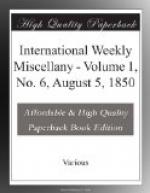“The immediate influences of this camaraderie are highly flattering and apparently beneficial to the subject of them, but its ultimate effects are most injurious to the proper development of his powers. When the merest trifles that a man throws off are inordinately praised, he soon becomes content with producing the merest trifles. Longfellow has grown unaccustomed to do himself justice. Half his volumes are filled up with translations; graceful and accurate, indeed; but translations, and often from originals of very moderate merit. His last original poem, Evangeline, is a sort of pastoral in hexameters. The resuscitation of this classical metre had a queer effect upon the American quidnuncs. Some of the critics evidently believed it to be a bran-new metre invented for the nonce by the author, a delusion which they of the ‘Mutual Admiration’ rather winked at; and the parodists who endeavored to ridicule the new measure were evidently not quite sure whether seven feet or nine made a hexameter. It is really to be regretted that Longfellow has been cajoled into playing these tricks with himself, for his earlier pieces were works of much promise, and, had they been worthily followed out, might have entitled him to a high place among the poets of the language.... Longfellow’s poetry, whenever he really lays himself out to write poetry, has a definite idea and purpose in it—no small merit now-a-days. His versification is generally harmonious, and he displays a fair command of metre. Sometimes he takes a fancy to an obsolete or out-of-the-way stanza; one of his longest and best poems, The Skeleton in Armor, is exactly in the measure of Drayton’s fine ballad on Agincourt. His chief fault is an over-fondness for simile and metaphor. He seems to think indispensable the introduction into everything he writes of a certain (or sometimes a very uncertain) number of these figures. Accordingly his poems are crowded with comparisons, sometimes very pretty and pleasing, at others so far-fetched that the string of tortured images which lead off Alfred




